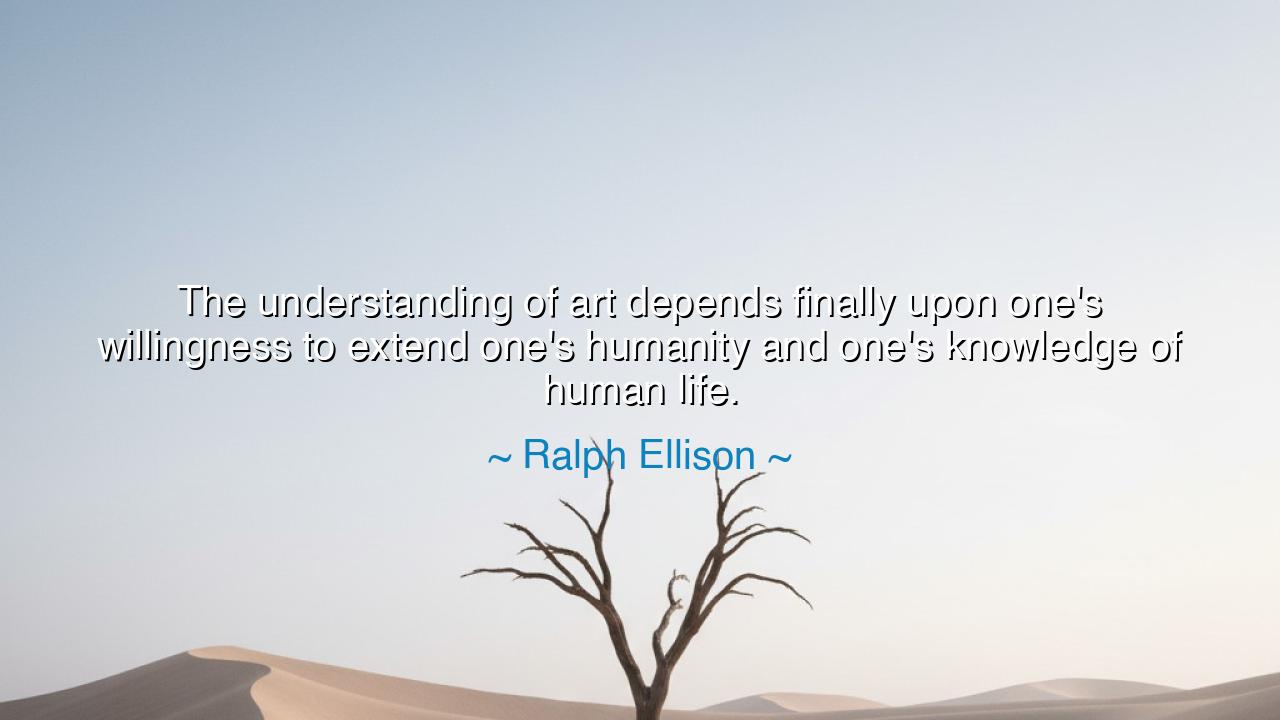
The understanding of art depends finally upon one's willingness
The understanding of art depends finally upon one's willingness to extend one's humanity and one's knowledge of human life.






The words of Ralph Ellison—“The understanding of art depends finally upon one's willingness to extend one's humanity and one's knowledge of human life”—speak with the resonance of timeless truth. Ellison, the author of Invisible Man, was a man who looked deeply into the soul of his nation and saw that art is not a decoration of life—it is a revelation of it. His words remind us that to understand art is to understand people, and that beauty, truth, and meaning are not found in technique alone, but in the depth of empathy and awareness that the heart is willing to cultivate. Art, in this sense, is not a mirror only—it is a bridge between souls, a dialogue between the inner world of one and the shared destiny of all.
When Ellison speaks of “extending one’s humanity,” he means that to truly comprehend art, one must stretch beyond the boundaries of self. The artist creates from his own struggle, joy, pain, and wonder; the viewer must therefore meet that creation not as a stranger, but as a fellow traveler. Art demands participation, not observation. It asks that we open our hearts to the experiences of others—their sorrow, their laughter, their contradictions—and find within them echoes of our own. In this, the understanding of art becomes a spiritual act: a movement of compassion, a reaching outward toward the vastness of human existence.
This truth has been known to every civilization that has ever sought to express its soul through form. In the temples of Greece, where sculptors shaped marble into gods, art was not worship of stone but of human potential—the divine reflected in mortal beauty. In the songs of Africa, the rhythms and chants were not mere music, but a testament of memory and survival, born from suffering and community. And in the frescoes of Michelangelo, painted upon the ceiling of the Sistine Chapel, the human form stretches toward the divine, as if creation itself were the act of understanding. In every age, art becomes a measure of how deeply a people have felt, how far they have reached into the heart of what it means to live.
Ellison, who wrote from the wounds and triumphs of the African American experience, understood that art’s power lies in its capacity to awaken empathy. He saw that those who refused to extend their humanity—who shut their eyes to suffering or difference—could never truly understand the art born of it. To grasp the meaning of a jazz improvisation, for example, one must feel the tension between discipline and freedom, oppression and expression. To understand his novel Invisible Man, one must see not just a single man’s invisibility, but the blindness of a society that refuses to see. Art, for Ellison, was the living record of the human struggle to be seen, known, and remembered.
In this way, the knowledge of human life becomes the foundation of all artistic understanding. Knowledge here is not intellectual—it is experiential. It is the kind of wisdom that comes from living, from feeling deeply, from walking among others with an open heart. The one who has known joy will see light in a painting; the one who has known sorrow will hear truth in a song. To the shallow observer, art remains a puzzle of colors and shapes; to the awakened soul, it becomes a map of humanity itself. Thus, Ellison teaches that we cannot separate art from life, nor life from the moral imagination that art demands of us.
Consider the story of Vincent van Gogh, who lived in poverty and isolation, yet painted the world with such compassion that his brush seemed to breathe the suffering and beauty of all humankind. When one looks at The Starry Night, one does not merely see the sky above a sleeping town; one feels the pulse of longing, the restlessness of the human soul reaching for peace. To understand that painting is to feel what Van Gogh felt—to extend one’s humanity until it encompasses both despair and wonder. And so it is with all great art: its meaning is not delivered, it is discovered—through empathy, humility, and love.
The lesson Ellison offers is both simple and profound: if you wish to understand art, you must first understand life—and to understand life, you must open yourself to others. Learn to listen to stories not your own. Walk through the world with curiosity instead of judgment. Let joy and grief, beauty and pain, teach you how to see. Art is not something apart from us; it is the expression of what we all share: the hunger to be known, the courage to feel, the will to endure.
Therefore, let every soul who seeks wisdom remember this: the heart is the true interpreter of art. Knowledge without compassion sees only the surface; but compassion, joined with knowledge, sees the living spirit beneath. To extend one’s humanity is to approach the divine, for in understanding another’s creation, we come closer to understanding ourselves. And in that sacred recognition—in that widening of the soul—we find the true purpose of both art and life: not to separate, but to unite; not to escape reality, but to transform it through love.






AAdministratorAdministrator
Welcome, honored guests. Please leave a comment, we will respond soon